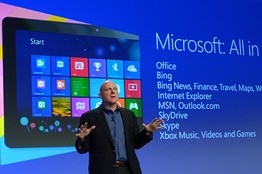
As Microsoft launches Windows 8 today, CIOs are figuring out what to make of the most dramatic overhaul of the operating system since 1995—and perhaps ever. While some reports have suggested that the new user interface, beautiful though it may be, is beyond the comfort level of some long-time Windows users, the larger question may be how things go for the companies that do make the transition.
The touch-screen oriented Windows 8 system, designed to run on PCs, tablets and phones, does away with the familiar start button and replaces it with a start screen that features brightly colored “tiles” that display live information. Gartner predicts that most corporate users, many of whom are still using much older versions of Windows, will be slow to adopt Windows 8. Gartner says90% of companies globally have no plans to deploy it broadly through at least 2014.
Justin Lane/EPA Microsoft CEO Steve Ballmer speaks during the launch of the Windows 8 operating system in New York City, October 25, 2012.
“It’s a big release for us, a very big release, the biggest since Windows 95, and even then you can say that (Windows 95) didn’t have the same level of innovation as Windows 8,” said Edwin Visser, senior director in the Windows business group, who oversees marketing to commercial customers, including small and medium-size businesses and large enterprises.
To get a sense of how large companies are adjusting to the new operating system, CIO Journal sat down with Visser and with two early adopters—companies that have used working versions of Window 8 to develop applications. CIO Journal spoke to Russ Rosen, CIO of Rooms to Go, a furniture retailer with $1.3 billion in annual revenue. It also spoke with two executives from 20th Century Fox—Tanya H. Tallino, vice president of enterprise information technology, and Cristina Mancini, senior vice president of worldwide marketing in the television distribution group.
They are among a wider group of early adopters. Windows 8 Enterprise, a version of the operating system with special features for CIOs and corporate IT users, has been downloaded about 500,000 times since it was made available on August 16, Visser says. Those features allow users to log in remotely without a VPN, using visual security systems based on patternsusers make when they touch the screen. It also includes Windows To Go, which puts a version of Windows 8 on a thumb drive, so that users can access their corporate desktop from home, using any device.
While Microsoft wasn’t about to put companies with complaints about Windows 8 in front of CIO Journal, their accounts of working with Windows 8 may be instructive nonetheless. After all, no one put a gun to Rosen’s head and forced him to develop applications for Windows 8. In fact, Rosen said he was hard at work on the development of a mobile sales tool for Windows 7 before Microsoft offered him an opportunity to give Windows 8 a try. He already had made the decision not to use another mobile platform such as Android or iOS.
The app will be used in the company’s 190 showrooms, each of which have about a dozen sales representatives, all of whom will be equipped with tablets. They replace PC work stations in the showrooms. “The work stations did the job, but we wanted something more informal, so that a sales rep and a customer could sit on a couch together,” Rosen said.
He said he preferred the Windows 8 environment from the start, because he and his staff of 60 IT workers didn’t have to scrap previous development work done in other versions of Windows. While he never went live with a Windows 7 mobile app, effort that he made on that platform was salvageable. Rosen said he also was most comfortable with the level of security that Windows 8 offered.
Now he is trying to figure out whether to use Windows 8 or the version known as Windows RT. That is a question many CIOs will have to sort out.
Windows 8 will run on Intel processors, and run applications developed for Windows 7. Windows RT is similar, but runs on lower-powered ARM processors used in mobile phones and many tablets. It will support lighter, thinner and cheaper devices than Windows 8. But unlike Windows 8, it won’t run applications developed for Windows 7. Rosen said he is drawn to Windows RT because of the devices. But he is still considering Windows 8 because it would allow him to push applications and updates to machines on masse, via the virtual desktop interface.
ARM chips that power phones and many tablets—regardless of whether they run Windows RT, iOS or other operating systems—have a “sandbox” architecture that prevents viruses from being a major issue, the way they are for desktops. As CIO Journal reported earlier: “To prevent viruses from being a major issue, the smartphone and tablet operating systems were structured to prohibit an application from writing to the files of another application, referred to as a sandbox architecture. Like those more modern systems, Windows Phone 8 and RT use this same sandbox architecture, and that means System Center cannot have a single background process or global update.”
Mancini and Tallino used Windows 8 to develop a mobile app for Fast Fox, a 13-year-old desktop tool that allows salespeople and broadcasters to access 20th Century Fox content and promotional materials. The app allows users to access entire films. Security was critical—content had to have digital rights management and digital “watermarks,” according to Mancini. While those security features are feasible using other development platforms, she said she found them easiest to implement in a Windows environment.
And Tallino said Windows 8 allowed her team to develop the app very quickly. “We had a proof of concept in two days, and an app in 30 days,” she said.

 Home
Home